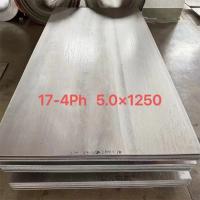S32750 round bar sheet cutting parts high temperature resistant
custom stainless steel alloy.
S32750 is a super duplex stainless steel with excellent corrosion
resistance and high strength for harsh environments. It is mainly
used in marine engineering, chemical processing, oil and gas
extraction and other fields. The tensile strength and corrosion
resistance of S32750 make it perform well in these fields and
become the preferred material for these applications. In addition,
S32750 is also used in industries such as oil refining,
fertilizers, papermaking, petroleum and chemicals.

Chemical Composition
The chemical composition of S32750 stainless steel includes:
Chromium (Cr): 22.0%~26.0%
Nickel (Ni): 6.0%~8.0%
Molybdenum (Mo): 3.0%~4.5%
Nitrogen (N): 0.20%~0.35%
Iron (Fe): Balance
| Cr | Ni | Mo | N | Fe |
| 22.0%~26.0% | 6.0%~8.0% | 3.0%~4.5% | 0.20%~0.35% | Balance |
Other elements such as carbon (C), silicon (Si), phosphorus (P),
sulfur (S), etc. also have specific content limits.
Physical properties
Density: 8.03 g/cm³
Melting point: 1300-1390 ℃
| Density: |
| 8.03 g/cm³ |
| Melting point: |
| 1300-1390 ℃ |

1. The phase ratio needs to be controlled. The most suitable ratio
is that the ferrite phase and the austenite phase each account for
about half, and the amount of one phase cannot exceed 65% at most,
so as to ensure the best comprehensive performance. If the
two-phase ratio is unbalanced, for example, the amount of ferrite
phase is too much, it is easy to form single-phase ferrite in the
welding HAZ, which is sensitive to stress corrosion cracking in
certain media.
2. It is necessary to master the organizational transformation law
of duplex stainless steel and be familiar with the TTT and CCT
transformation curves of each steel grade. This is the key to
correctly guide the formulation of duplex stainless steel heat
treatment, hot forming and other processes. The precipitation of
brittle phases in duplex stainless steel is much more sensitive
than austenitic stainless steel.
3. The continuous use temperature range of duplex stainless steel
is -50 to 250℃. The lower limit depends on the brittle transition
temperature of the steel, and the upper limit is limited by the
brittleness of 475℃. The upper limit temperature cannot exceed
300℃.
4. Duplex stainless steel needs to be cooled quickly after solution
treatment. Slow cooling will cause the precipitation of brittle
phases, resulting in a decrease in the toughness of the steel,
especially the resistance to local corrosion.
5. The lower limit temperature of hot processing and hot forming of
high chromium-molybdenum duplex stainless steel cannot be lower
than 950℃, super duplex stainless steel cannot be lower than 980℃,
and low chromium-molybdenum duplex stainless steel cannot be lower
than 900℃, to avoid surface cracks caused by the precipitation of
brittle phases during processing.
6. The 650-800℃ stress relief treatment commonly used for
austenitic stainless steel cannot be used, and solid solution
annealing treatment is generally used. When the overall stress
relief treatment of 600-650℃ is required after duplex stainless
steel is surfacing on the surface of low alloy steel, the toughness
and corrosion resistance caused by the precipitation of brittle
phases, especially the decline in local corrosion resistance, must
be considered, and the heating time within this temperature range
should be shortened as much as possible. The heat treatment of low
alloy steel and duplex stainless steel composite plates should also
be considered in the same way.
7. It is necessary to be familiar with the welding rules of duplex
stainless steel, and the welding of austenitic stainless steel
cannot be applied to all of them. Whether the equipment of duplex
stainless steel can be used safely is closely related to the
correct mastery of the welding process of steel. The failure of
some equipment is often related to welding. The key lies in the
control of line energy and interlayer temperature, and the correct
selection of welding materials is also very important. The
two-phase ratio of the welded joint (weld metal and welded HAZ),
especially the necessary amount of austenite in the welded HAZ, is
very important to ensure that the welded joint has the same
performance as the parent material.
8. When selecting duplex stainless steel in different corrosive
environments, it should be noted that the corrosion resistance of
steel is always relative. Although duplex stainless steel has good
local corrosion resistance, for a certain duplex stainless steel,
it also has an applicable medium condition range, including
temperature, pressure, medium concentration, pH value, etc., which
needs to be carefully selected. Many of the data obtained from
literature and manuals are laboratory corrosion test results, which
often differ from the actual conditions of the project. Therefore,
attention should be paid when selecting materials. If necessary,
corrosion tests in actual media or coupon tests under field
conditions, or even tests of simulated devices, need to be carried
out.











